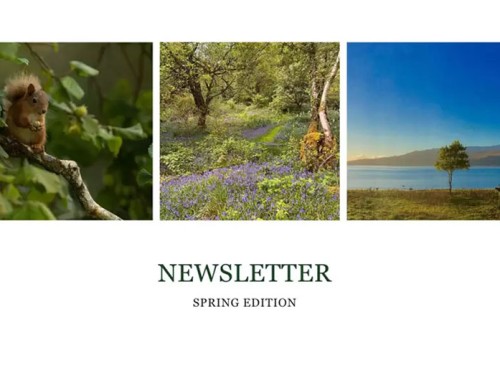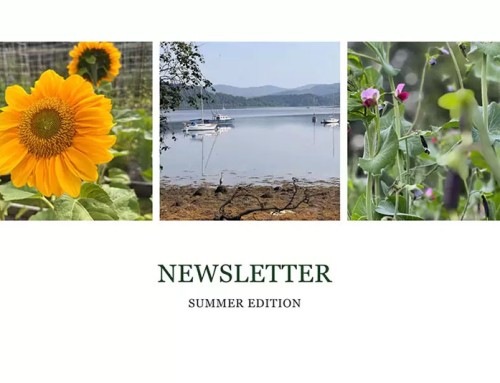A word from Dennis Overton, OBE, Chairman of the Ardtornish Estate Company.
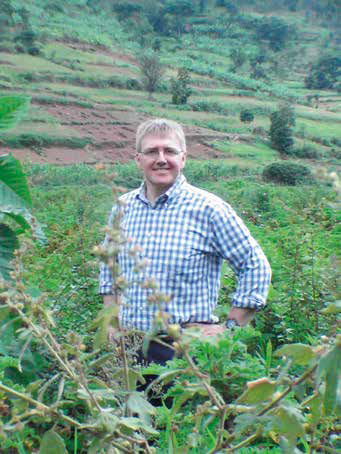
Dennis Overton, OBE
I’m delighted to introduce this, our third such annual report, on behalf of the team at Ardtornish – and to thank them for the year’s work that it records.
My tasks as chair of the board are made easier by settled policies that we work towards. The Raven family have agreed a clear and comprehensive statement of purpose. It is this.
To run a profitable and businesslike estate, to maintain and enrich its natural and cultural heritage, and to develop sustainably its value for the benefit of both the family and the community. To keep the place in good heart, to make it somewhere that feels, looks and is healthy, happy, enterprising and well run. To promote it to visitors and the wider world. To see its natural assets of landscape, wildlife and an increasingly strong community as the foundations of its business success, and to ensure that any development does not degrade or erode them.
That guides and inspires the board, the executive team, and me. Between us, we’ve set out the values that we try to embody. They include continuity, and continual improvement. Teamwork, respect, integrity and trust are vital too. We value our links with the local community, and with the wider communities of interest that influence what we do – very much including our visitors, the lifeblood of an important part of our business.
The year highlighted something that we forget at our peril. The difficulties of running a business in a remote area with an exceptionally harsh climate were unusually clear. There is more detail below. The essential services we need – transport and digital communications in particular – are not always reliable. Being close to nature is one of the delights of working in Morvern. But when nature turns violent, business can be hard to manage – as it was in the winter 2015-16.
I’m delighted to say nonetheless that 2016 was another good year. We strengthened our board by welcoming Tony McInnes, chief executive, as a full member. As a company we are succeeding, and continually improving. As we get stronger, so, we hope and intend, does our contribution to the community of Morvern.
People
The Ardtornish population grows and shrinks as new families arrive, resident ones expand, youngsters grow up and move away, colleagues leave for new jobs. Sometimes we say a long farewell to those who die.
We congratulated Caroline and Richard Mullen on the birth of their third child Dean Owen, and Ally Nudds and Mairi Jackson on their marriage. We bid goodbye to James Cameron, who after several years with us has decided to take up a ship’s engineer post with Calmac on the Fishnish ferry. We wish him well with his new career. Duncan Gallagher was a very welcome recruit to our trades team in September.
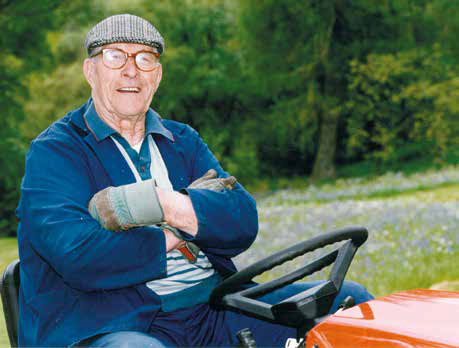
Charles Ives (chubby) 1920 -2015
In early February, Charles Ives – universally known as Chubby – died in hospital in Fort William. At 95, Chubby was the oldest member of the Ardtornish community.
Born the youngest of three in Edinburgh in 1920, he came here when his Londoner father – retired from the Royal Navy – got a job and moved to Ardtornish in 1928 with his lowland Scots wife. Chubby left Claggan school a month after his 14th birthday, and worked for the Forestry Commission, contracted to Ardtornish marking trees in the estate woods. He did various jobs with the Commission, until in 1939 he was again contracted to the estate, ultimately becoming a key member of the farm staff. A keen sportsman, Chubby was the local champion at both badminton and golf – being famously fit and strong.
In 1946 he married Maggie Cameron, daughter of the Old Ardtornish shepherd. After the ceremony in the hotel – Chubby recalled that ‘most weddings around the wartime were not in the church but in the house or the hotel’ – they had two sittings of dinner for almost a hundred guests, with a speech to each from the groom, topped off with three celebratory explosions on the foreshore using powder from the mine.
Their son Charles was born in July 1952 in Glencoe Maternity Hospital. He too went to Claggan Primary School, then boarded at Oban High School, and away to agricultural college at Auchincruive near Ayr. There at a disco he met Jill – a trainee teacher – and they married in 1976. Kirsty and Ross were born in 1978 and 1980, and with his great-grandchildren Cameron and Andrew were a source of great pride to Chubby.
Maggie died in 1980, too young, at 58, while away visiting the younger members of the Ives family in Ayr. Chubby was devastated: it had been a very happy marriage.
He looked after the Ardtornish hirsel with great dedication for over thirty years, also being taken on as the part-time keeper of Ardtornish Point lighthouse. In the 1980’s he transferred to maintenance of the garden of Ardtornish House, where for many years he was a familiar figure atop his orange ride-on mower keeping the greenswards tidy and trim.
He retired ultimately to Castle Cottage. His reeking lum, always open door and hearty hail featured there for more than twenty years, as scores of visitors came time and again to visit and to blether. Around a hundred Christmas cards were received and dispatched from and to the four corners of the globe. A nonagenarian in a remote rural parish, Chubby was one of the best networked people you’d ever meet. His near-perfect recall and keen eye made him a great companion. He’s a huge loss.
At the end of the year, Ardtornish salaried staff numbered 21 (down from 22 in 2015), whose families included seven children of school and nursery age (down from nine). A further eight (the same number as at the end of 2015) are on the payroll.
Around Ardtornish
The winter of 2015-16 was exceptionally windy and wet. The series of storms – starting with Abigail, the first named officially by the Met Office – caused significant problems, before finally blowing through with Katie in late March. Eleven storms over winter is extreme even by West Highland standards.
Perhaps more than ever before in living memory, they made working life in Morvern difficult indeed. Power cuts were frequent and some of them long. Ferries, inevitably, were disrupted. Roads were blocked with fallen trees. Most vulnerable were the telecommunications. Landline, internet, and mobile telephone connectivity was cut repeatedly and several times for days on end. Linespeeds were awful. It wasn’t all the utilities’ responsibility: we ourselves managed to cut the BT cable with a digger during renewable energy groundworks, leaving several houses without connections for frustratingly long. This weary series of events gave meaning to the need for resilience – the business buzzword of the moment.
In some good news, Vodafone installed 3G in the village – part of its community outreach programme. Hotspots are the school, pontoons and shop.
Fortunately structural damage was limited. We had a near-miss when a heavy clay cowl was blown off an Ardtornish House chimney, narrowly clearing a large glass skylight but putting a dent in the lead roof. The wrought-iron and chrome sculpture before the front lawn took a battering, and required repair by sculptor John Creed. We hired a huge cherrypicker and between the storms had a closer look at the exterior of Ardtornish House. Progress was good with roofing issues and painting wooden facings – but by enabling us to get up close to the more inaccessible parts of the front façade, it revealed as many problems as it solved.
We strengthened the track to Torr Molach and tidied up around the Old Kennels, preparatory to upgrading both as holiday accommodation, now Simon and Liz have moved to the renovated Claggan Cottage. Two more and final blasts in the Hillside quarry were invaluable to give a good supply of crushed roadstone – though the second was more exciting than we planned, as it gave the Hillside Cottages a nasty shake.
 We installed a defibrillator at Achranich.
We installed a defibrillator at Achranich.
Besides the storms there was dry weather too, which allowed good progress in the kitchen gardens. We had to remove the last remaining greenhouse, as unstable and a safety hazard. In due course we shall replace it. We upgraded the drainage, and created new hard standings to improve access. It’s excellent to see the garden back in production, and we’re proud again to put fresh local produce on sale.
The garden at Ardtornish House got a bit knocked about, but was well maintained by Allan Davidson – who has less of a battle with red deer intrusion now the new cattle grid and front gates are in situ and operational. We continue our 25-year campaign against invasive rhododendron, and were pleased to see recognition that we are winning with a commendation from Scottish Natural Heritage.
Energy
Very high rainfall in January, July, August and September gave good conditions for hydro. The power outages did not. We had the driest October for over 20 years, and at the year-end had measured 2184mm (86 inches) of rainfall – only a shade over our long-term average. Electricity generation was interrupted several times in late summer and autumn when SSE instructed us to turn off our turbines, citing the health and safety requirements of their grid upgrading team. Unforeseen and uncompensated, this made a hole in our expected earnings, and was not helpful to long-term debt repayment.
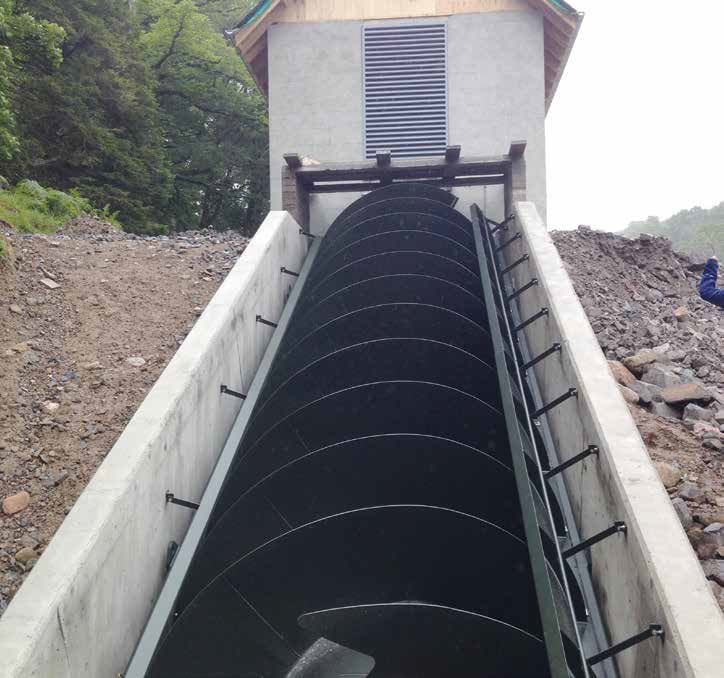
Our main construction project was the 100kw-rated Archimedes Screw Turbine on the river Rannoch at Achranich. With an intake just above and the turbine some 50 metres below the early nineteenth century humpback bridge, it’s a low-head scheme. With little fall, at 4.4 metres from top to bottom, its power to generate comes more from water volume than pressure. Piped beneath the road, the water rises up again to the same level as the intake (physicists call this the syphon effect) in the turbine house itself, set high on the right bank of the Rannoch. It then tumbles into the turbine – a giant corkscrew 2.7 metres wide and over ten long, set at 26 degrees from the horizontal.
Commissioned in August, it can generate most of the time, as the Tearnait and Rannoch hydroschemes upstream smooth the peaks and troughs of water volume, and deliver to the screw a more regular supply. The turbine itself is sculptural and mesmeric – a great addition to our energy investments. The whole pleasing effect is enhanced by a new fish pass on the weir beneath the bridge – a stainless steel triumph of engineering giving a narrow frothy channel of fish-navigable flow.
In the summer the equipment began arriving for our fifth and final hydro scheme, the Socaich burn extension to the Rannoch system. It will capture water from the Achranich hill, pipe it to generate electricity in a new power-cum-boathouse on the banks of Lochan Lub an Arbhair (the Rannoch dam loch), and by discharging water into the lochan, increase the Rannoch and screw turbine schemes’ output too as they use each drop a second time. By the year end construction was well advanced, and on schedule to commission in September 2017.
Tourism
 A weak pound and nervousness about security on the continent greatly increased 2016 visitor numbers to the Highlands. We were no exception. It was by far our busiest year.
A weak pound and nervousness about security on the continent greatly increased 2016 visitor numbers to the Highlands. We were no exception. It was by far our busiest year.
We increased our social media profile, and used different agents to reach new markets. Numbers of passing visitors rose with new signs on the A884 at the Ardtornish turn south of Larachbeg. Sales rose sharply from our shop beside the estate office, where we’re proud to sell the best in local crafts, alongside books and guides and excellent homeproduced venison, beef, mutton, hogget and lamb.
Kathryn and our housekeeping team got great feedback on improved standards of presentation of the cottages and apartments in Ardtornish House. Business expansion took a step forward when we bought West Pier House in Lochaline, and resumed occupation of Torr Molach, which we shall return to holiday letting in the coming months.
Several coach tours enjoyed visiting the gardens, as did visitors by sea when the Hebridean Princess tied up at the West Pier. Many of our visitors now regard a visit to the Whitehouse Restaurant as a vital part of the Morvern experience. Like them, we were delighted when in August it was listed as The Good Food Guide Local Restaurant of the Year for 2016.
Achabeag
The Achabeag settlement reached a milestone when the second phase of serviced plots sold out. Completion of a sixth and final house ended construction on phase one. Services improved with a natural stone bin store, escape lane on the main road entrance, and improved drainage across the B849.
We also received consents for the final phase, and look forward to working with Highland Small Communities Housing Trust to deliver five more affordable homes in addition to the two occupied on phase one.
Wildlife
Like the rest of Morvern, Ardtornish is known for its pine martens. In early January, we found one escaping the weather curled up fast asleep in the warmth of the Rannoch powerhouse. Our neighbour Matthew Wilson of Morvern Wildlife Experience conducted a Morvern-wide survey, and found evidence of martens in most of the peninsula’s kilometer squares – though they may not be resident in each, but rather just passing through. The next stage is more detailed work to give a population estimate. Matt is working with the Vincent Wildlife Trust, which is also busy translocating martens to Wales – taken from areas in Scotland with plenty, to others in south Wales with none. Four went south from our resident population, and radio tracking tells us all four are doing well in their new home.
Wildcats have been much in the news, and Morvern – having been confirmed as one of six priority areas where they are being intensively studied by Scottish Wildcat Action – had its first intensive campaign of camera trapping. 150 cameras were deployed, and showed that to judge by their markings, we do have some cats with strong pure wildcat genes.
The number of geese increases each year. At times over a hundred feed on our better fields at Claggan. They are mainly Canada, but grey geese are here aplenty too. The birdwatchers among us like to see them. The farmers do not. We all like the curlews, which winter here still, often in double figures – unlike so many areas from which they’re now completely gone. After a long absence we again had a sea-feeding kingfisher, and among the rare migrants not one but two yellow-browed warblers in the neighbourhood – part of a continental invasion of that attractive and distinctive species.
In another poor year, the river Aline produced 10 salmon and grilse and seven sea trout to rod and line. With the local fisheries trust we are researching the effects of removing the salmon farm smolt cages from Loch Arienas – sending water and sediment samples off to Stirling University for analysis. Gill netting produced several trout up to three pounds for analysis and scale sampling.
We culled 64 stags and 97 hinds in the 2016-17 season, and in August, at Uladail, got a (fortunately rare in Morvern) sighting of a sika stag.
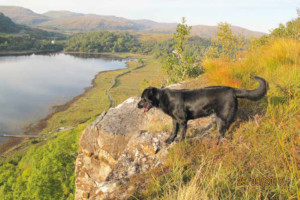 Among the wonderful local flora we found a new woodland site for the narrow leaved helleborine (Cephalanthera longifolia), in flower in May. We were notified by Scottish Natural Heritage that the several designated woodland sites (areas of particular natural heritage importance) on Ardtornish were in poor condition, substantially due to overgrazing. We are reviewing herbivore numbers as a result, and expect to reach some conclusions during 2017. Alongside that review, we are also considering native woodland expansion, and shall be consulting our neighbours as the plans develop.
Among the wonderful local flora we found a new woodland site for the narrow leaved helleborine (Cephalanthera longifolia), in flower in May. We were notified by Scottish Natural Heritage that the several designated woodland sites (areas of particular natural heritage importance) on Ardtornish were in poor condition, substantially due to overgrazing. We are reviewing herbivore numbers as a result, and expect to reach some conclusions during 2017. Alongside that review, we are also considering native woodland expansion, and shall be consulting our neighbours as the plans develop.
In 2015 we were notified that the tree disease ash dieback had reached two areas in Morvern. 2016 brought similar news on larch. Phytophthora ramorum – also called sudden oak death syndrome – is known to be a problem in larch and rhododendron on Mull. So far there is no sign of either at Ardtornish, but we fear we may get both – and consequently may soon fell some mature larch if the disease does not get them first.
A large party of mycologists stayed at Ardtornish House in the autumn, and among a huge host of specimens they found some pretty hazardous ones in the garden.
Farm
Atrocious winter weather was tough on both shepherds and their stock. Besides the usual impact of predation by ravens, crows, foxes and perhaps others, we lost a couple of tups to drowning, and – to various causes – hoggs in double figures.
Prices in 2016 were no cause for excitement. Early in the year, cast sheep fetched poor money, averaging £24 for the few dozen animals sold. The lowest for Blackfaces reached £6 – a level so dismal it hasn’t been seen for years.
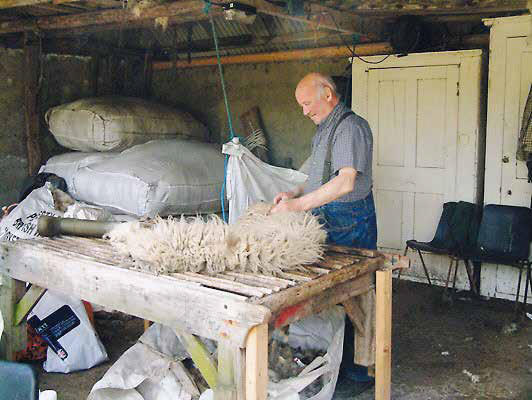 The 2015 wool clip averaged 89p per kg, down 8% on 2014. At least the low price was offset by an 8% increase in weight. Calf sales were no better, averaging £2.87 per kilo (down from £3.22 the year before – an 11% fall). Lambs at least were reasonable, realising £37.70 per head at the main sale of the year, up 6% from the £35.43 average for 2015. Our organic calves fared better, reaching £680 per head, though they too were down a tad from the £5 more we got the year before.
The 2015 wool clip averaged 89p per kg, down 8% on 2014. At least the low price was offset by an 8% increase in weight. Calf sales were no better, averaging £2.87 per kilo (down from £3.22 the year before – an 11% fall). Lambs at least were reasonable, realising £37.70 per head at the main sale of the year, up 6% from the £35.43 average for 2015. Our organic calves fared better, reaching £680 per head, though they too were down a tad from the £5 more we got the year before.
Expert stockbreeder John Nudds again did well at the shows, winning the gimmer class at Salen on Mull – but atrocious early-August weather meant he left his lambs at home. Nine out of ten Ardtornish animals were placed at the Sunart show, including two firsts and four seconds – but no silverware for us in 2016.
We made around 550 large bales of silage, and ended the year with the two separate farming units running some 1575 ewes and 193 breeding cows.
In the community….
Morvern Community Development Company goes from strength to strength. We are delighted to help by donating staff time. Cala Loch Alainn – the harbour facilities it has so successfully developed – had a good year, so much so that during 2016 plans were finalized and funds raised for swinging moorings and further berths on the pontoons. Alongside it, thanks to the energy of a small volunteer committee that runs the Sailing Club, the community can now boast ownership of a small fleet of dinghies, regularly to be seen out on the loch under the expert guidance of the commodore and his assistants.
Some renewable energy developers make an annual community benefit payment. We believe Ardtornish was the first private estate to sign up to Highland Council’s target payment level of £5,000 per megawatt of capacity (most developers, if they do make a payment, provide less). Such funds can benefit communities at Highland Council level, or more locally. Ardtornish supports the Morvern Community Trust – benefiting the community in the parish of Morvern. We were pleased again in 2016 to pay £12,000, reflecting the size of our Tearnait and Rannoch schemes. For the Uileann and Achranich hydro schemes, we also contribute £5,000 per megawatt per year, in this instance to the Ardtornish community fund, which benefits the same population as Morvern Community Trust. During 2016 the fund made grants to Burach (the Gaelic choir), Lochaline school (for swimming lessons, an outing and a barbecue), the nursery and toddler group, the Three Lochs book festival, the community land association, community development company, Ardnamurchan Tourist Association, and others.
Transport remains a critical issue to a community like Morvern’s. Maintaining links by road and sea does not get any easier. Local government austerity brought further deterioration in road maintenance, with carriageways in poor condition and reduced winter gritting. Corran Ferry – a Highland Council service, and essential lifeline for Morvern – saw further fare increases, prompting our former veteran Highland Councillor to condemn the ‘more than forty per cent fare increases in the past three years’.
A dilemma of a different sort beset the Lochaline to Fishnish ferry. Fare reductions on the Oban to Craignure crossing to Mull – under the Scottish Government’s road equivalent tariff scheme – saw traffic increase on that crossing as it dropped away on ours. Oban to Craignure passenger traffic rose 16% (to almost 650,000) in 2016, while cars increased over 40% (to 162,000).
Lochaline to Fishnish passenger crossings meanwhile fell by 4.3% to 105,000, with cars down just over 5% to 43,000. The feeling locally is that the high-cost Corran Ferry – used by most cars and passengers crossing from Mull to the mainland via Morvern – is a major part of the cause. It’s clear people will not pay for both ferries now the other route is so much cheaper.
Morvern residents work on the ferry and on Mull, and go to school there too. It’s one to watch for the future – a worry that illustrates well the fragility of life in a place so remote.

